Warwickshire Dragonfly Group - News page
Last Flights Table
First Flights Table
November 16th 2017 - Common Darter still flying
October 25th 2017 - Late flying dragonflies
October 17th 2017 - Late flying damselflies
October 4th 2017 - Records for 2017,
Report on Red-veined Darter, Red-veined Darter infested by ectoparasites & Southern Hawker male at our garden pond
2017 records
Jeff Rankin's 2017 Red-veined Darter sighting report
An interesting photo of a Red-veined Darter infested by ectoparasites.
A flying Southern Hawker male at our garden pond.
August 19th 2017 - Red-veined Darter at Marsh Lane - the continuing story
August 17th 2017 - Red-veined Darter at Marsh Lane Reserve - again
August 10th 2017 - Website records updated, Migrant Hawker exuvia and damselfly carrion
July 27th 2017 - First 2017 report of Migrant Hawker
July 24th 2017 - Report on the early summer dragonfly happenings
May 31st - Red-veined Darter sighting
July 17th - Fight for the best spot to emerge
June 19th 2017 - Report on the Chalecote Park and Paxton Pits field meetings
Saturday June 10th - Paxton Pits
Saturday May 27th - Charlecote Park
May 22nd 2017 - Update on flying species and Hairy Dragonfly at Ryton Wood
May 7th 2017 - Azure Damselfly and Four-spotted Chaser flying - updated for Blue-tail and Hairy Dragonfly.
April 22nd 2017 - Common Blue Damselfly emerging and many Large Red Damselflies at Bubbenhall Meadow
April 13th 2017 - First flying damselflies this year and a very early Banded Demoiselle!
March 13st 2017 - Using iRecord for your sightings.
February 2017 - Report for
2016 published in the BDS Darter journal.
Table of
Latest Dates Recorded in Warwickshire
Species
|
Date 2017
|
Latest before 2017
|
Site for 2017
|
Recorder 2017
|
| Azure Damselfly. | 6.9.2017
|
15.9.1969
|
Bishop's Farm, Austrey
|
Mr Elumalai |
| Banded Demoiselle. | 26.9.2017
|
3.11.1995
|
Wormleighton Reservoir.
|
Jon Bowley |
| Beautiful Demoiselle. | 29.7.2017
|
3.9.2012
|
Dene, Kineton
|
Glenn Arkinstall |
| Black-tailed Skimmer. | 28.8.2017
|
23.9.2016
|
Barnrooden Farm
|
Kay & Peter Reeve |
| Blue-tailed Damselfly. | 24.9.2017
|
12.10.1990
|
Bubbenhall Meadow
|
Kay & Peter Reeve |
| Broad-bodied Chaser. | 26.8.2017
|
31.8.1992
|
Sutton Park, Sutton Park: Streetly Heath - S6
|
Richard Orton,Sutton Pk.Grp. |
| Brown Hawker. | 19.9.2017
|
27.10.2014
|
Middleton Lakes, RSPB Reserve
|
Member RSPB team |
| Common Blue Damselfly. | 17.10.2017
|
17.11.2011
|
Bubbenhall Meadow
|
Kay & Peter Reeve |
| Common Darter. | 16.11.2017
|
6.12.2009
|
Bubbenhall Meadow
|
Kay & Peter Reeve |
| Emerald Damselfly. | 24.9.2017
|
2.10.2015
|
Bubbenhall Meadow
|
Jim Timms |
| Emperor Dragonfly. | 4.10.2017
|
12.10.2012
|
Hay Wood, Baddesley Clinton
|
Jon Bowley |
| Four-spotted Chaser. | 25.7.2017
|
1.9.2009
|
Sutton Park, Sutton Park: Streetly Heath - S6
|
Richard Orton,Sutton Pk.Grp. |
| Hairy Dragonfly. | 16.6.2017
|
5.7.2016
|
Alvecote Pooley Fields
|
Andy Barnsley |
| Large Red Damselfly. | 17.7.2017
|
31.8.1983
|
Ufton Fields
|
Chris & Annette Baker |
| Migrant Hawker. | 25.10.2017
|
20.11.2014
|
Draycote
|
Kay & Peter Reeve |
| Red-eyed Damselfly. | 1.9.2017
|
15.9.2012
|
Lapworth Street, by Stratford Canal
|
Jon Bowley |
| Red-veined Darter. | 19.8.2017
|
20.8.2001
|
Marsh Lane Nature Reserve, Hampton in Arden
|
Graham Rowling |
| Ruddy Darter. | 24.9.2017
|
25.10.2011
|
Bubbenhall Meadow
|
Kay & Peter Reeve |
| Small Red-eyed Damselfly. | 31.8.2017
|
30.9.2015
|
Tithe Farm Pond
|
Kay & Peter Reeve |
| Southern Hawker. | 25.10.2017
|
12.11.2015
|
Brinklow - Disused Canal
|
Jon Bowley |
| Southern Hawker. | 25.10.2017
|
12.11.2015
|
Bubbenhall Meadow
|
Jim Timms |
| White-legged Damselfly. | 1.9.2017
|
19.9.2015
|
Lapworth Street, by Stratford Canal
|
Jon Bowley |
If you have any later dates for 2017 or
later times for previous years please let me have them.
Back to page top
Table of
Earliest Dates Recorded in Warwickshire2017
Species
|
Date 2017
|
Earliest before 2017
|
Site for 2017
|
Recorder 2017
|
| Azure Damselfly. | 3.5.2017
|
28.4.2011
|
Bubbenhall Meadow
|
Jim Timms |
| Banded Demoiselle. | 4.4.2017
|
20.4.2011
|
Tame, Ladywalk Nature Reserve
|
Paul Casey |
| Beautiful Demoiselle. | 15.5.2017
|
30.4.2011
|
Arrow, Wixford
|
Mick Schilling |
| Black-tailed Skimmer. | 23.5.2017
|
6.5.2011
|
Charlecote Park, Lake
|
Kay & Peter Reeve |
| Blue-tailed Damselfly. | 7.5.2017
|
22.4.2011
|
Charlecote Park
|
Martin Roberts |
| Blue-tailed Damselfly. | 7.5.2017
|
22.4.2011
|
Charlecote Park
|
Mick Schilling |
| Broad-bodied Chaser. | 14.5.2017
|
23.4.2011
|
Packmore Community Garden, Warwick
|
Agni-Louiza Arampolglou |
| Brown Hawker. | 16.6.2017
|
8.6.2009
|
Alvecote Pooley Fields
|
Andy Barnsley |
| Common Blue Damselfly. | 22.4.2017
|
23.4.2011
|
Bubbenhall Meadow
|
Steve Batt |
| Common Darter. | 19.6.2017
|
10.5.1982
|
Bubbenhall Meadow
|
Jim Timms |
| Emerald Damselfly. | 11.6.2017
|
21.5.2007
|
Morton Bagot
|
R.E. Harbird |
| Emperor Dragonfly. | 26.5.2017
|
13.5.2011
|
Purley Chase, Purley Quarry, Mancetter
|
Keith Warmington |
| Four-spotted Chaser. | 7.5.2017
|
23.4.2011
|
Bubbenhall Meadow
|
Kay & Peter Reeve |
| Hairy Dragonfly. | 9.5.2017
|
26.4.2007
|
Alvecote Wood
|
Sarah Walters |
| Large Red Damselfly. | 11.4.2017
|
12.4.2011
|
Bubbenhall Meadow
|
Kay & Peter Reeve |
| Migrant Hawker. | 8.7.2017
|
18.6.1996
|
Avon, Welford-on-Avon
|
Mick Schilling |
| Red-eyed Damselfly. | 21.5.2017
|
2.5.2011
|
Stour, Alscot
|
Glenn Arkinstall |
| Red-veined Darter. | 31.5.2017
|
10.6.2007
|
Marsh Lane Nature Reserve, Hampton in Arden
|
Roy Ledbury |
| Ruddy Darter. | 18.6.2017
|
24.6.2003
|
Morton Bagot
|
R.E. Harbird |
| Small Red-eyed Damselfly. | 16.6.2017
|
19.6.2014
|
Alvecote Pooley Fields
|
Andy Barnsley |
| Southern Hawker. | 14.6.2017
|
10.5.1982
|
Ufton Fields, Dragonfly Pond
|
Chris & Annette Baker |
| White-legged Damselfly. | 22.5.2017
|
14.5.2003
|
Avon, Marlcliff
|
Kay & Peter Reeve |
If you have any earlier dates for 2017 or
previous years please let me have them.
Back to page top
If you have any later dates for 2017 or later times for previous years please let me have them.
Back to page top
November 16th - Common Darter still flying
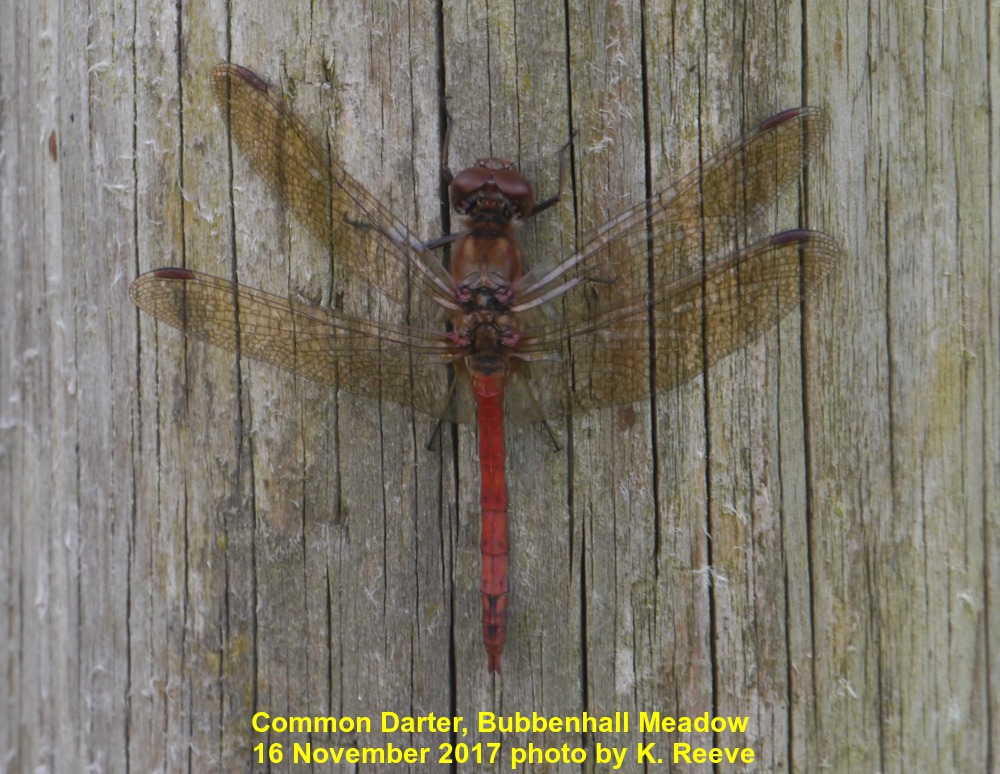 Bubbenhall Meadow continues giving. Yesterday, 15th November, Jim Timms saw a Common Darters at Bubbenhall Meadow.
And today at about 11am on the 16th Kay and Peter Reeve spotted the one in the photo - typically sitting on a wooden post. The sun had been out about
half-an-hour earlier but had gone in by the time it was seen. The temperature was around 10 deg.C.
Bubbenhall Meadow continues giving. Yesterday, 15th November, Jim Timms saw a Common Darters at Bubbenhall Meadow.
And today at about 11am on the 16th Kay and Peter Reeve spotted the one in the photo - typically sitting on a wooden post. The sun had been out about
half-an-hour earlier but had gone in by the time it was seen. The temperature was around 10 deg.C.
So Common Darter is still about in small numbers - it is worth getting out to see the last few flying dragonflies of 2017 in the next few days (or weeks?).
|
Back to page top
October 25th - Late flying dragonflies
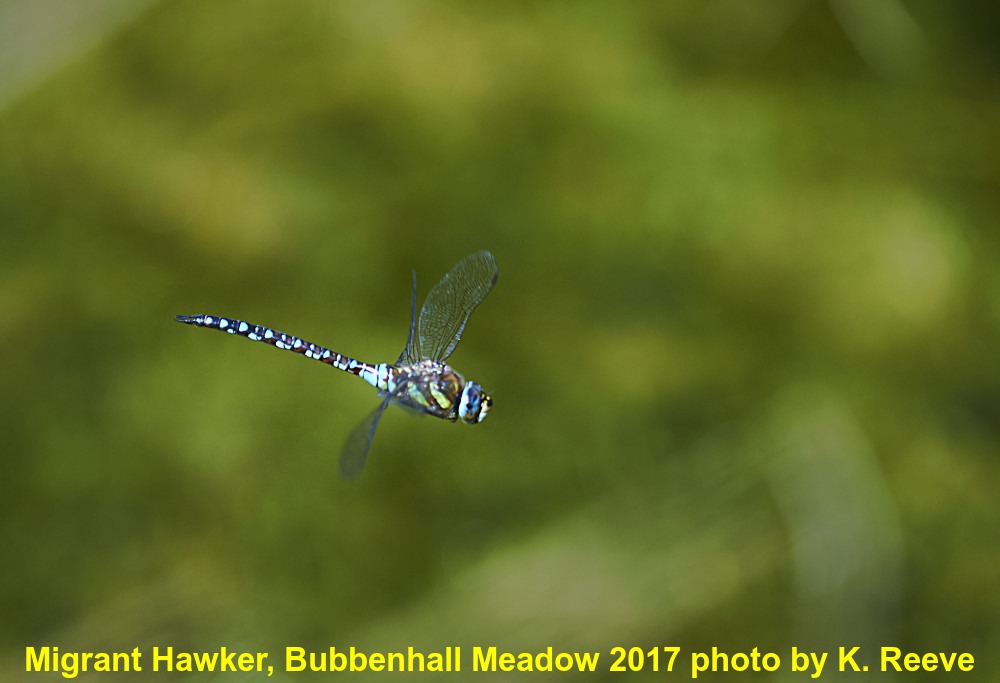 There are still late flying dragonflies, some in quite significant numbers. The last flights table shows
the current status of the latest dates for all species in the county.
There are still late flying dragonflies, some in quite significant numbers. The last flights table shows
the current status of the latest dates for all species in the county.
The 25th October was warm and sunny and brought out good numbers of dragonflies. Jim Timms saw a
Southern Hawker and more than 20
Common Darters at Bubbenhall Meadow. There is still a couple of weeks to go
for Southern Hawker before the latest ever date for the county is passed. If the weather
is kind it may yet happen this year.
The same day I (Peter Reeve) visited a site at Draycote village and had a very interesting couple of hours.
There are three pools on the site - West , Middle and East - which are each each about 0.5 hectare in extent.
I arrived at the West Pool about 11.30.
The sun was veiled by thin cloud but just casting a shadow. The temperature was about 15deg.C and there was a light NW breeze.
There were a few male Common Darters on the bank making short excursions.
Fifteen minutes later there was full sun and I moved to a more sheltered part of the bank.
Suddenly there were tens of Common Darters over the water with some mating and egg laying pairs.
They were joined by two or three male Migrant Hawkers
patrolling the marginal reed bed - no doubt looking for egg laying females.
As I moved into an area more exposed to the breeze on West and Middle Pools the numbers of individuals fell.
I had high hopes of finding more individuals at East Pool. It is separated from the first two and protected from the wind
by a high hedge and trees. On arriving there about 12.20 imagine my disappointment on finding only a couple
of Common Darters and apparently nothing else. But continuing around the lake I was rewarded by
finding not one, not two, but three or possibly more male Migrant Hawkers patrolling the reed bed searching
for females. They were very tolerant of each other.
The sun was still in a cloudless sky so I returned to the protected bank on West Pool at about 13.10.
Now there were only a few Common Darters and one Migrant Hawker present. Conditions were, if anything, better than earlier in the day.
Why was there so much less activity now? It is well known that for some species of dragonfly there is
a maximum number of males that can hold territory together. There is a turn over of males as the early
arrivals tire and depart and are replaced by fresh individuals. Does this happen with Common Darters? Here's a
hypothesis: the early arrivals exhausted the pool of potential males slots. When those ones tired and left to recuperate and feed,
because the total local populations had more or less come in on the first shift, there were only a few left to replace them.
Earlier in the season when the total population is greater, no detectable drop
in breeding activity is seen.
|
Back to page top
October 17th - Late flying damselflies
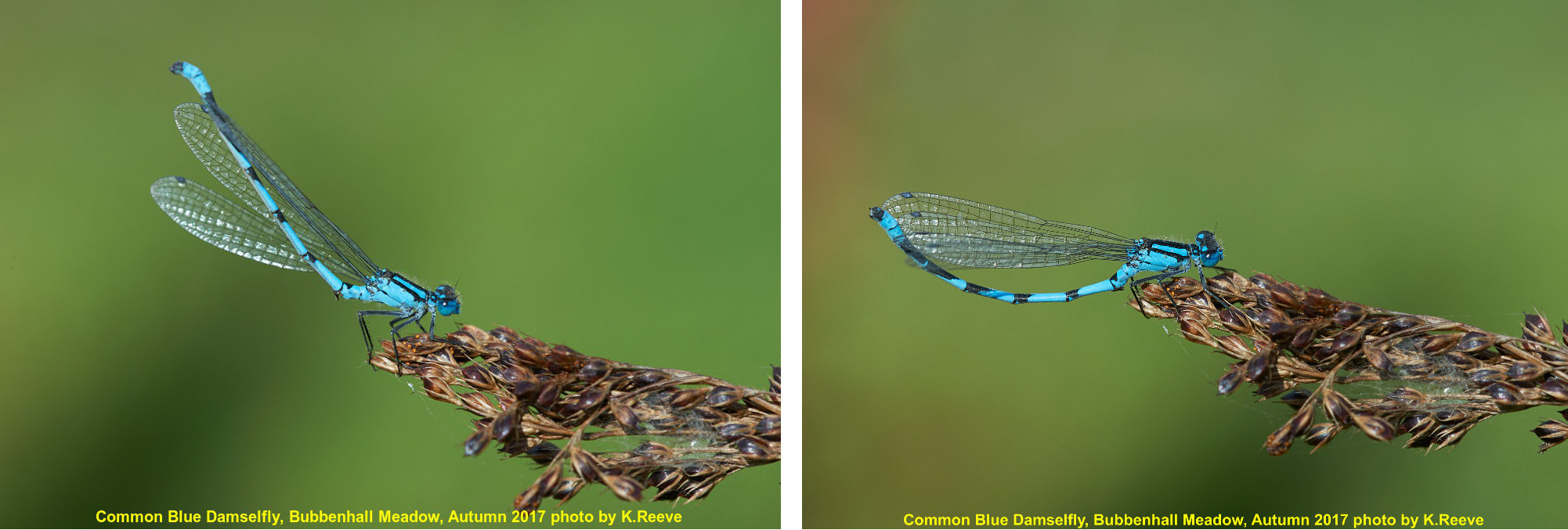 For damselflies the latest record received so far this year is for several Common Blue Damselflies found by Kay and Peter Reeve at Bubbenhall
Meadow on 17th October. Over twenty individuals were seen on the three large pools and mating and egg laying were observed too.
For damselflies the latest record received so far this year is for several Common Blue Damselflies found by Kay and Peter Reeve at Bubbenhall
Meadow on 17th October. Over twenty individuals were seen on the three large pools and mating and egg laying were observed too.
These two pictures were taken earlier in the month at Bubbenhall and they are of the same individual. They show an interesting behaviour.
It appears it was using its abdomen in a process of wing cleaning.
|
Back to page top
October 1st - Records for 2017,
Report on Red-veined Darter at Marsh Lane Reserve, Red-veined Darter infested by ectoparasites & Southern Hawker male at our garden pond
2017 recording
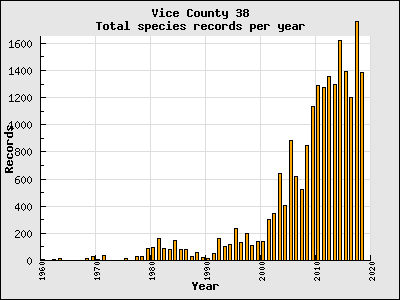 The histogram shows that the number of 2017 records received is high, the second highest year ever.
I know there are still a few more records to come in though whether they will be sufficient to exceed 2014 number is to be seen.
2017 is the first year that the iRecord online recording package has been extensively used. Many long time recorders have taken to it and in
addition a number of new recorders have joined the ranks encouraged by it. It use has been a success for users with few problems encountered (if this is not your experience
please let me know. There are however a few problems with data entry - exact species counts cannot be input; no fields are available to input monitoring data (monitors will
know what I mean). Hopefully, these limitations will be addressed.
The histogram shows that the number of 2017 records received is high, the second highest year ever.
I know there are still a few more records to come in though whether they will be sufficient to exceed 2014 number is to be seen.
2017 is the first year that the iRecord online recording package has been extensively used. Many long time recorders have taken to it and in
addition a number of new recorders have joined the ranks encouraged by it. It use has been a success for users with few problems encountered (if this is not your experience
please let me know. There are however a few problems with data entry - exact species counts cannot be input; no fields are available to input monitoring data (monitors will
know what I mean). Hopefully, these limitations will be addressed.
The user's problems are nothing compared to those for the Vice County recorder (me). The iRecord data has to be downloaded for our web site. The download feature
is nightmare - enough said.
|
Back to page top
Jeff Rankin's report on Red-veined Darter at Marsh Lane Reserve this year.
Jeff has written an excellent report about the Red-veined Darter. It can
be viewed here here.
Back to page top
An interesting photo of a Red-veined Darter infested by ectoparasites.
|
Robert Pugh photographed this Red-veined Darter in southern France in 2006 (N.B. Don't be confused by
the apparently black legs as I was. Look at the pterostigma, yellow outlined by black.). The wing veins
have many mites attached along them (to enlarge: click on the image and select View image).
Mites mites are discussed on page 73 of the book:
" Les Libellules de France, Belgique et Luxembourg" by Daniel Grand and Pierre Boudot, 2006
Biotope, Meze (Collection Parthenope) page73 and more briefly in "Field Guide to the Dragonflies & Damselflies of Great Britain
and Ireland" by Brooks et. al. Revised edition 2004 page 29.
In true researcher style we present a brief account of the life of the mites and their impact on their dragonfly hosts by plagiarising the above works
(using Kay's free rendering of Grand's French into English):
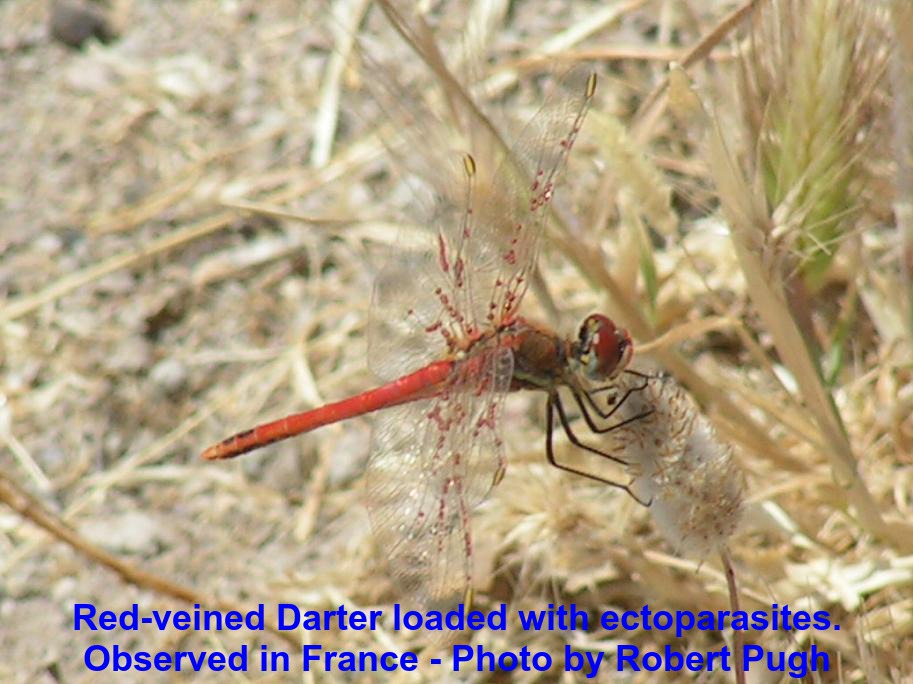
Some larvae of Hydracariens belonging to the
genus Arrenurus attach themselves to the larvae of certain species of
Zygoptera and Anisoptera, particularly in the genera Coenagrion (Blue damselflies)
and Sympetrum (Darter dragonflies).
During the host's emergence they quickly transfer from the larva to adult dragonfly and push their mouthparts into the
the body of Zygoptera or the wing veins of Anisoptera. They then imbibe the host's body fluids.
They will leave their host
and return to the water when they reach the reproductive phase.
This type of ectoparasitism by Hydracarians has consequences for the host.
Female fertility is reduced by 10-20%, and more generally there is a reduction in vitality and
competitiveness. Large numbers on the thorax or abdomen may even cause the death of the dragonfly host.
Some species of Hydracarians, such as Arrennurus papillator,
that live in temporary pools that dry up in summer take advantage of their host
to survive by forming nymphochrysalides - small balls on the veins of the wings of
some Sympetrum (this species is almost certainly the one shown in the photo).
In this phase they survive the summer season before returning to the water to breed and complete their life cycle.
A terse description of the life cycle of Arrenurus species can be found in
the summary of a paper by Stechmann, follow this link.
|
Back to page top
A flying Southern Hawker male at our garden pond.
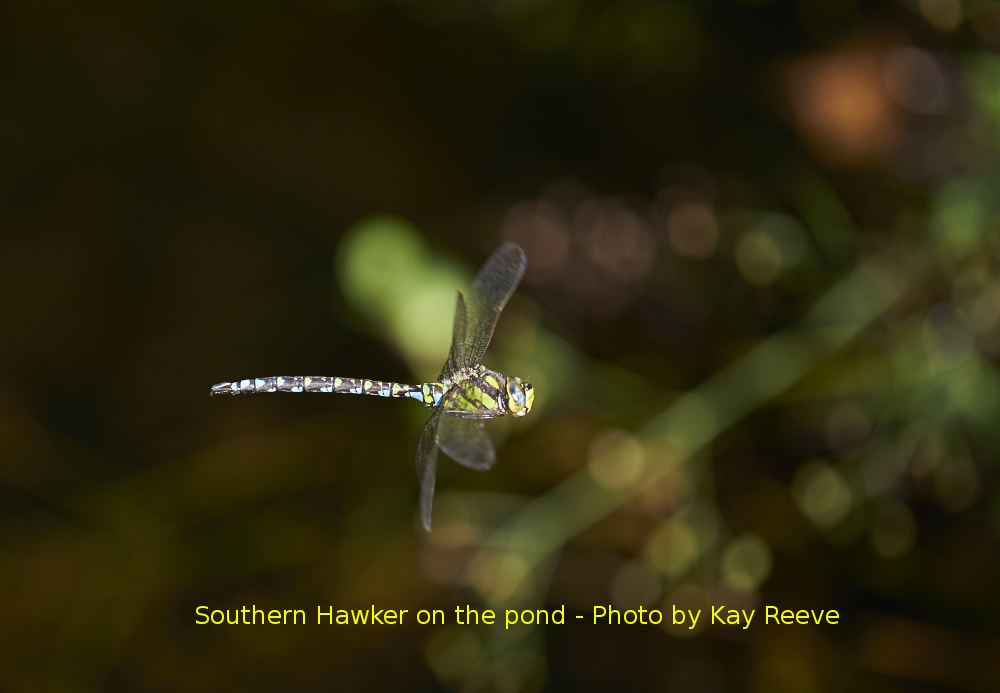
As an indulgence here is a photo of a male Southern Hawker taken by Kay on the 19th September holding territory
on our pond. The pond was only constructed in October last year.
|
Back to page top
August 19th - Red-veined Darter at Marsh Lane - the continuing story
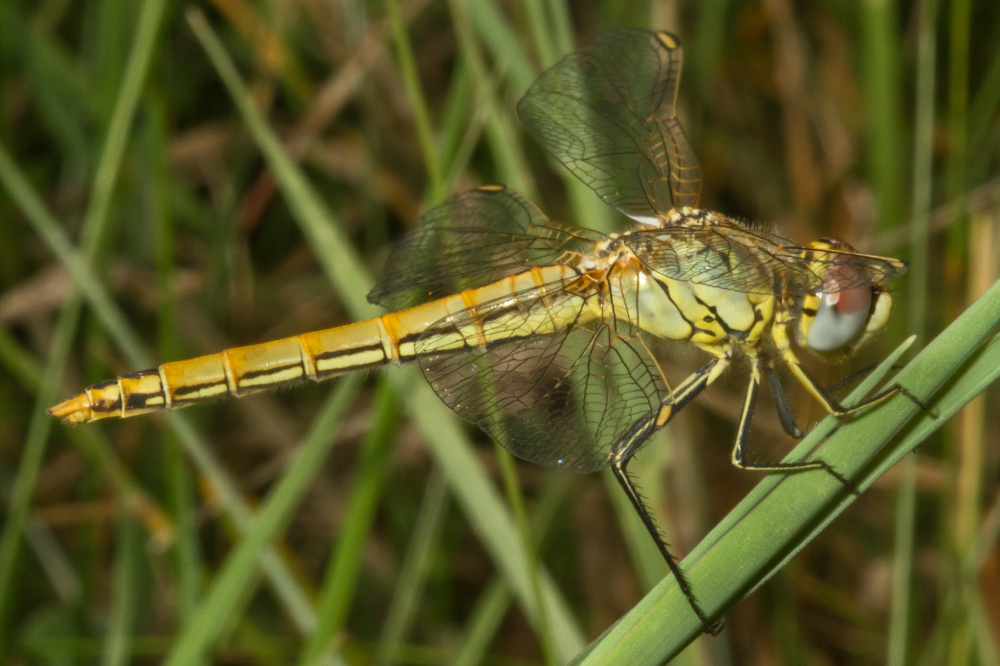
Photos by Jeff Rankin, Red-veined Darter, Marsh Lane 19 August 2017
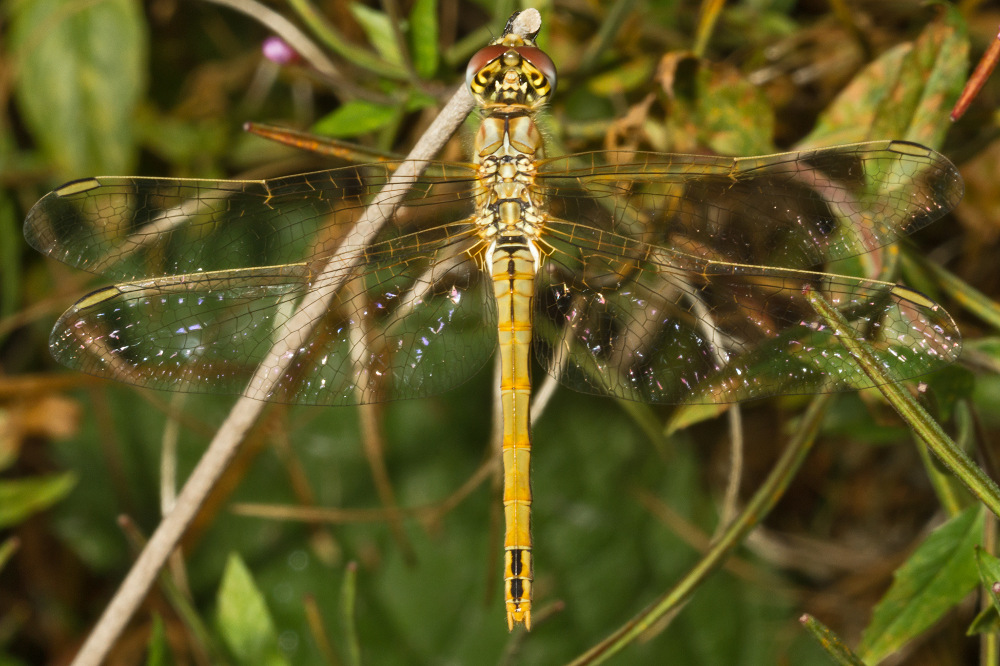
|
On 19th August Graham Rowling and Jeff Rankin did it again and found another Red-veined Darter at Marsh Lane Reserve. Jeff's photos or are on the left. It is a female. As with the specimen found on 17th August, it is recently emerged. This further evidence to support local emergence, probably at the Reserve. We should watch for breeding behaviour, copulation and oviposition.
|
Back to page top
August 17th - Red-veined Darter at Marsh Lane - again this year
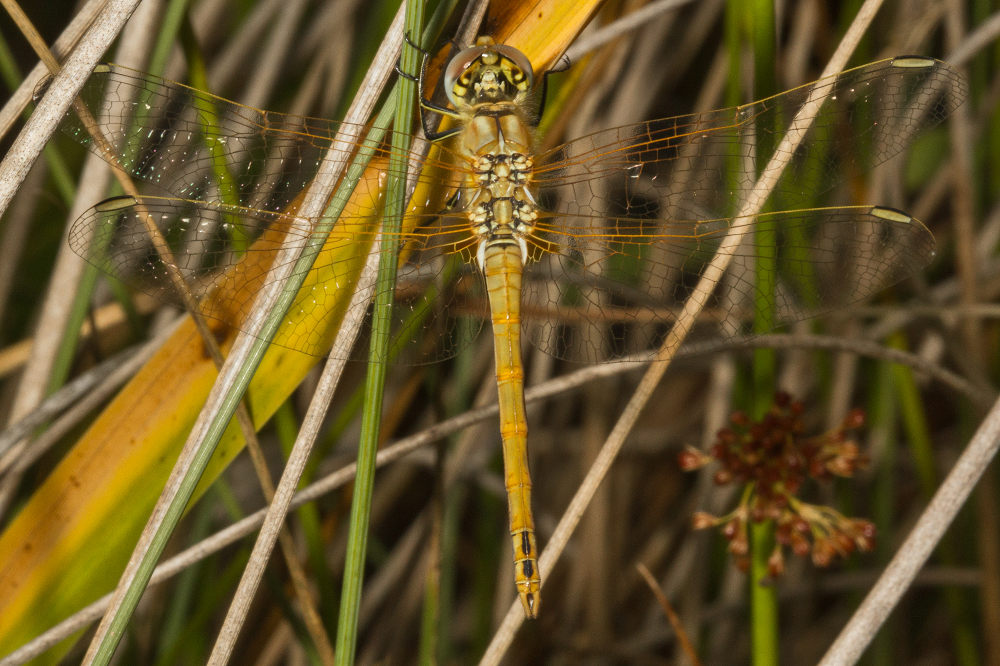
Photos by Jeff Rankin, Red-veined Darter, Marsh Lane 15 August 2017
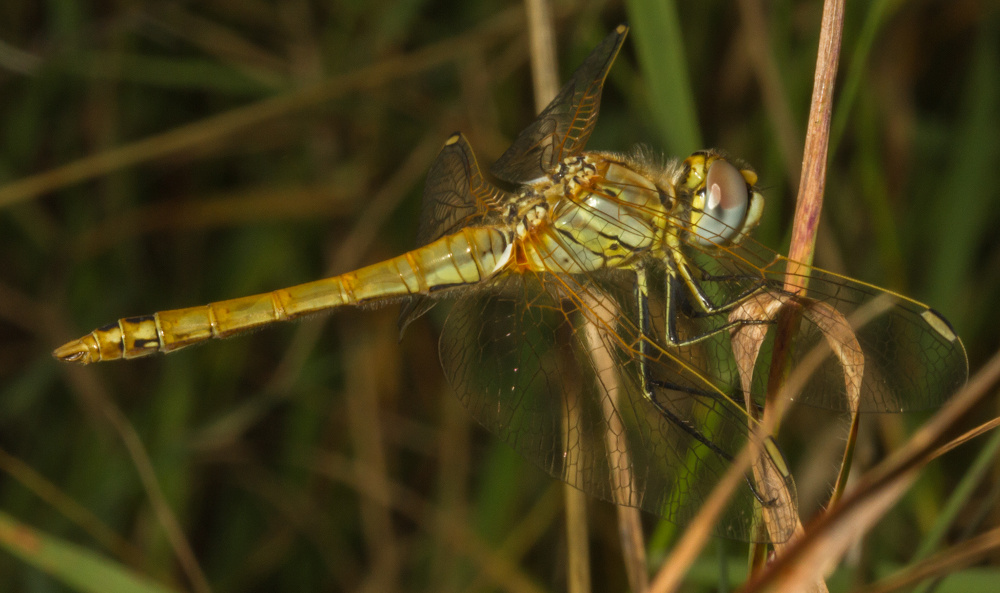
|
A Red-veined Darter
was seen at Marsh Lane on 15th August by Jeff Rankin and he
photographed it, see left. These show an immature specimen, probably a
male. There is good circumstantial
evidence that it emerged at Marsh Lane. The species larvae develop
rapidly and on the continent can go through up to two generations in one
summer and there were Red-veined Darter sighted at Marsh Lane in late
May/early June, see below. Of course, we will have
to await the finding of exuvia for absolute proof of breeding but it
highly probable it emerged somewhere near if not at Marsh Lane - a very
exciting event for Warwickshire!
|
Back to page top
August 10th 2017 - Website records updated, Migrant Hawker Exuvia and damselfly carrion
All the records sent to me and those entered on the iRecord Dragonflies or General data forms up to 7th August are now on this website. The distribution map data and the first flights data table are updated. There have been one or two changes to the first dates, hopefully now these are finalised for this year?
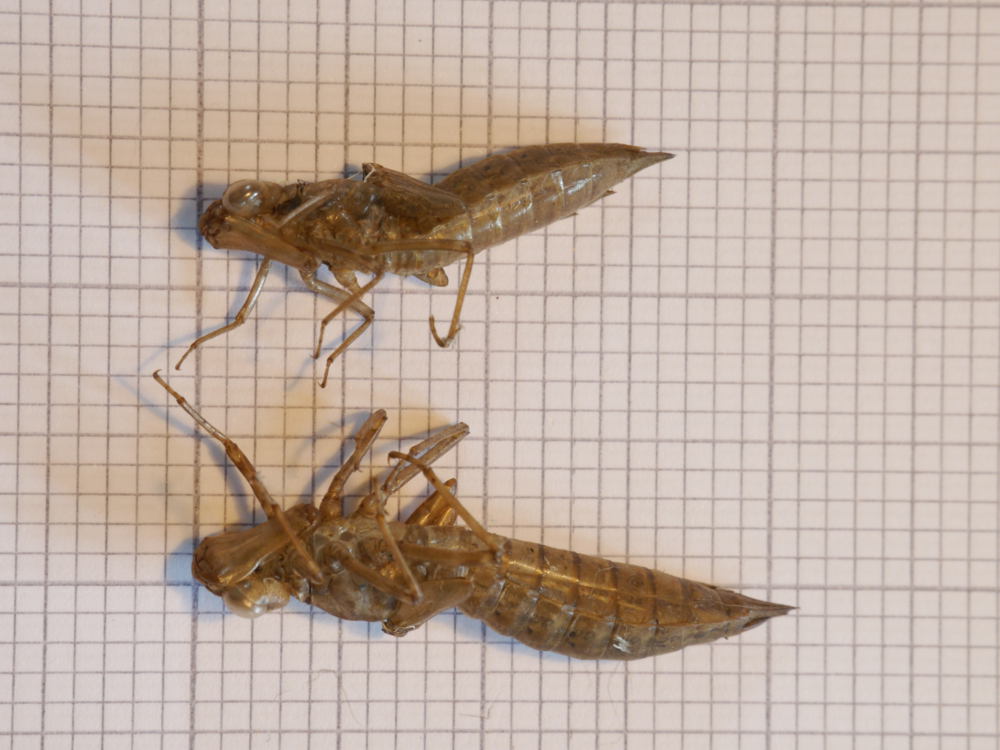
Photo by KMR, Migrant and Southern Hawker exuvia
|
Migrant hawker exuvia
Kay and Peter Reeve were recording at Wormleighton Reservoir on the 6th August and Kay spotted and recovered a Migrant Hawker exuvia. It is the height of the emergence period for the species now and they continue to emerge into September and
possibly even into the beginning of October. When you are out recording
it is worth keeping a eye open for Migrant Hawker exuvia.
Exuvia records are probably the most valuable for a species and site,
they prove that the life cycle has been completed there for the species.
Exuvia can be collected and kept for future reference or to get
confirmation of ID and there is no detriment to the dragonfly.
Migrant Hawker are very similar in shape, particularly their mask, to
Southern Hawker. However, they are easily separated from them by their
small size as the
photo shows. In the photo the Migrant is just over 32mm in length and
the Southern
about 42mm. Exuvia can vary in length but the Migrant Hawkers are always
less than 38mm. Note, both these specimens are males.
(Today another male Migrant Hawker exuvia was found on a pool at Draycote.)
|
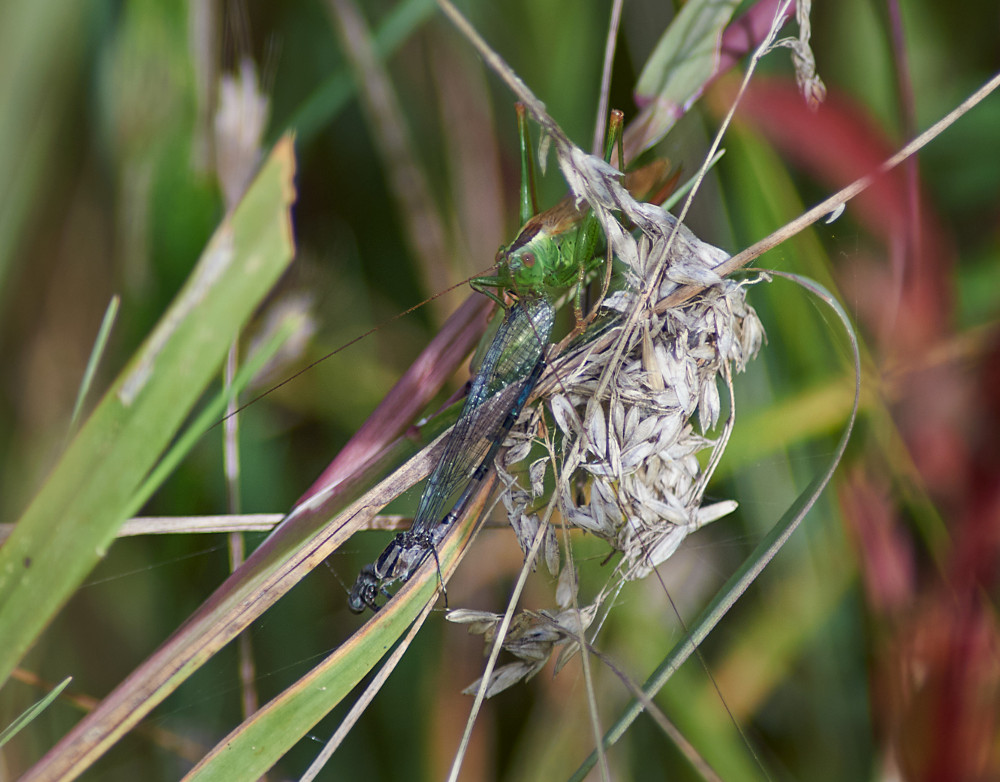
Photo by Kay Reeve, Long-winged Cone-head eating a Common Blue Damselfly
|
Damselfly as carrion
While recording at Bubbenhall
Meadow Kay and Peter came across this macabre sight, a Long-winged
Cone-head tucking into a dead male Common Blue Damselfly. A case of
carrion feeding. We presume the Common Blue was killed by the owner of the
grass nest it is on, some species of spider.
Does anyone know what species or family the spider belongs to?
(Today two damselflies were seen in a similar web at Draycote - no Long-winged Cone-head though.)
|
Back to page top
July 27th 2017 - First report of Migrant Hawker
On 8th July Mick Schilling saw three male Migrant Hawkers
at Welford-on-Avon on the river - apologies for being late with this
report. All our common breeding species are now about and flying. The first flights table has been updated and shows the earliest flight dates for all species with a record for this year in the Warwickshire database.
However, I am still catching up entering the backlog of records that
have been sent directly to me so there may yet be more changes to come.
If your records are entered using the on-line recording page they will appear more quickly on this website!
Back to page top
July 24th 2017 - Report on the early summer dragonfly happenings
The news update has been delayed by a couple of factors, a three week
holiday in (wet) Scotland and technical difficulties associated with
the move to iRecord web based recording - now, hopefully, resolved.
The best way to see how things have progressed since May is to look at the table of first flights. The majority
of our breeding species are now flying and the red highlighted rows
show quite a few species made early appearances. The particularly early
Banded Demoiselle was reported on below. Ruddy Darter and Small Red-eyed Damselfly
were significantly earlier this year by six and three days
respectively. However,
a number of early species, for example, Four-spotted and Broad-bodied
Chasers, were quite tardy in their appearance. This was probably because
of the cold spell in mid/late May.
May 31st - Red-veined Darter sighting
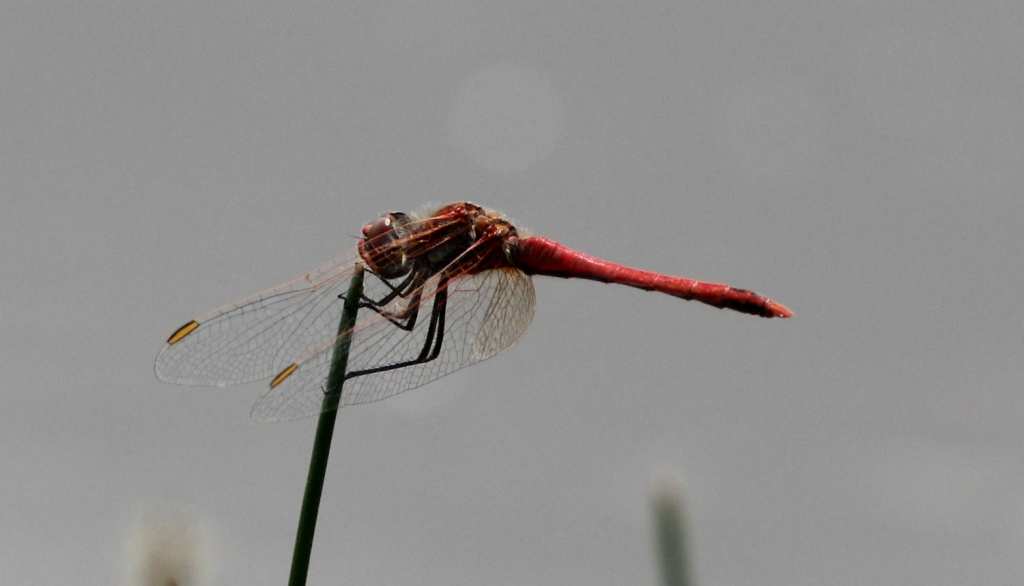
Photo by Roy Ledbury Red-veined Darter, Marsh Lane
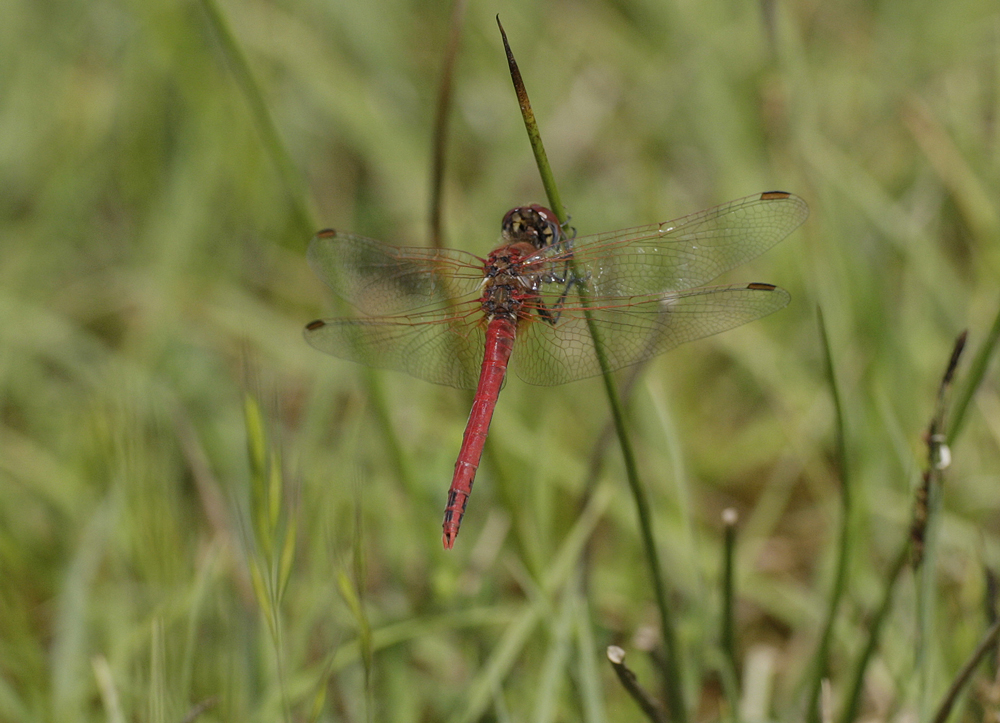
Photo by Dave Hutton Red-veined Darter, Marsh Lane
|
You will notice Red-veined Darter is in the first flights table. This attractive vagrant was seen first by Roy Ledbury at Marsh Lane Reserve 31st
May and photographed by him. There were several individuals
and they stayed around for at least another day. The following day
Dave Hutton saw three individuals there and was able to photograph them
too.
There have been records for the species in Warwickshire for
six of the years since 2000. The
sightings this year were part of a country wide immigration that
occurred in late May/early June. There were reports from the South Coast
to Cumbria.
|
July 17th Fight for the best spot to emerge
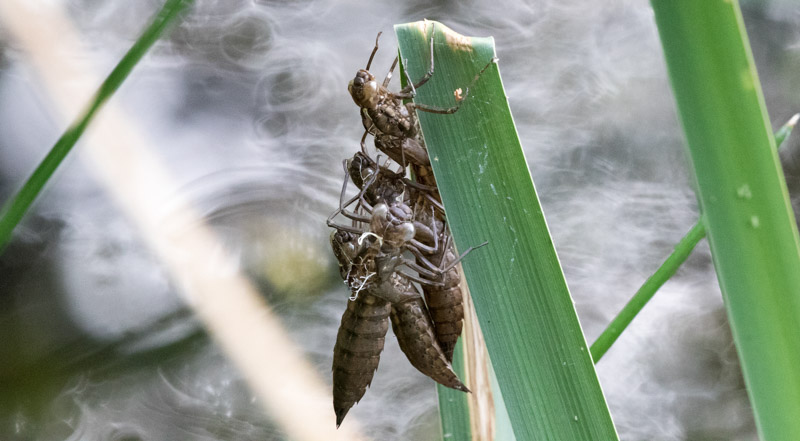
Photo by Steve Batt Southern Hawker exuvia, Bubbenhall Meadow
|
Steve Batt found at least 19 exuvia of the Southern Hawker
at a pond on the Bubbenhall Meadow Nature Reserve. His photo shows that
a good emergence point will be used again and again..... We can assume
that did not all emerged together.
|
Back to page top
June 19th 2017 - Report on the Charlecote Park and Paxton Pits field meetings
Saturday 10th June - Paxton Pits
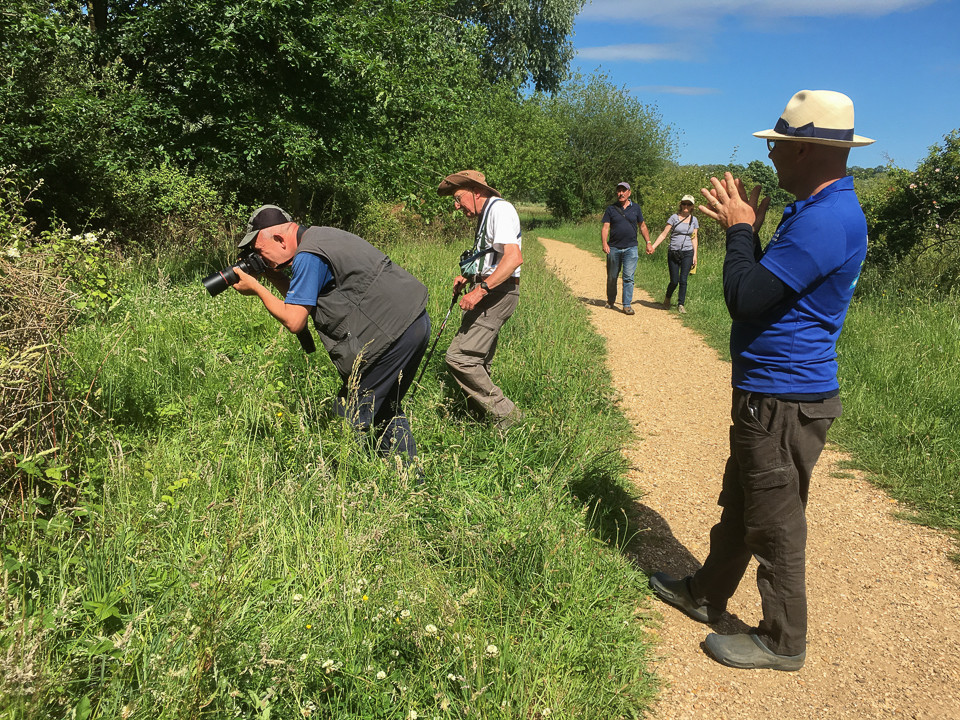
Photo by Kay Reeve - Some of the group at Paxton Pits
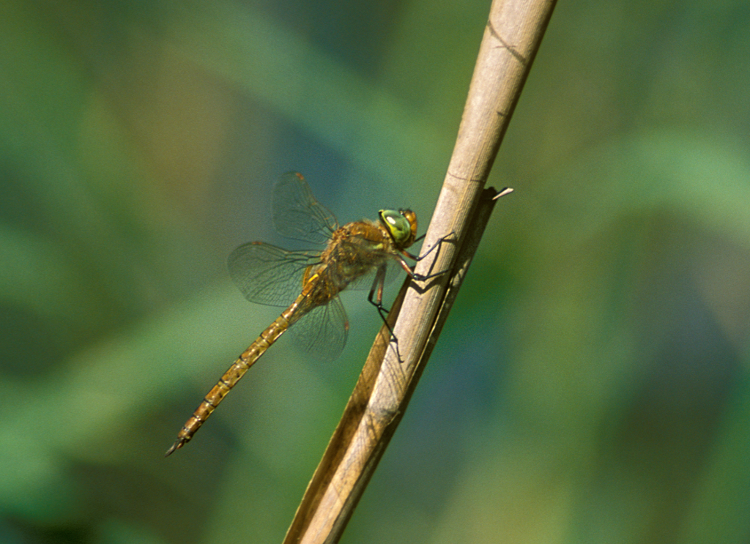
Photo by Kay Reeve - Green-eyed Hawker, Paxton Pits
|
The meeting was a repeat of one in 2015 which was spoilt by bad
weather. A week before this one the weather forecast for the Saturday
was dire. However, as the date approached the forecast gradually
improved and on the day when fourteen of us gathered at Paxton it was
bright sunny weather if a little windy. We set off for the pools - what a
day it turned out to be!
We walked along the path beside Cloudy Lake, see the Paxton Pits map, and with our first view across open water spotted a Green-eyed Hawker (Anaciaeshna isoseles, AKA Norfolk Hawker) - the first of the day. It was holding territory far from the Water Soldier (Stratiotes aloides) with
which it is associated in England. Our morning objective was to get to
Hayling Lake with extensive areas of Water Soldier but our progress
was slowed by the many damselflies and dragonflies we encountered on the
way. Hawking female and male Green-eyed Hawkers, Hairy Dragonfly (Brachytron pratense) and a maturing female Scarce Chaser (Libellula fulva).
On the south bank of Rudd Lake we were distracted by good numbers of Four-spotted
Chaser (L. quadrimaculata) with the males in active pursuit of females. Other dragonflies sighted were Brown Hawker (Aeshna grandis), immature Black-tailed Skimmer (Orthetrum cancellatum) and an immature Common Darter (Sympetrum striolatum). There were a good number of damselflies too. Variable Damselfly (Coenagrion pulchellumits ), Azure Damselfly (C. puella), Common Blue Damselfly (Enallagma cyathigerum), Blue-tailed Damselfly
(Ischnura elegans), Red-eyed Damselfly (Erythromma najas) and an early Emerald Damselfly (Lestes sponsa).
Eventually we reached the Hayling Lake Water Soldier beds and were not
disappointed. Despite the wind, male Green-eyed Hawkers were on patrol.
There were opportunities for the photographers, see left, and a number
of exuvia of Green Eyed Hawker, Emperor Dragonfly (Anax imperator) and Four-spotted Chaser were collected.There were more exuvia out of reach.
We returned to the Visitor Centre for lunch in a very happy mood.
After lunch some of the party visited the bank of the Nene to find
Scarce Chasers on territory. After fighting through a jungle of nettles
the waters edge was reached and, as expected, active males were found.A
very brave lady, Jill in shorts, pressed on into the nettles to find the
optimum spot for a photo.
Returning we passed a large Carp, an Otter kill, more or less untouched except for the liver which had been enjoyed.
Many thanks to Paul Claydon the county Countryside Ranger and his team,
especially those in the tea room, for their help and cooperation.
|
Back to page top
Saturday 27th May - Charlecote Park
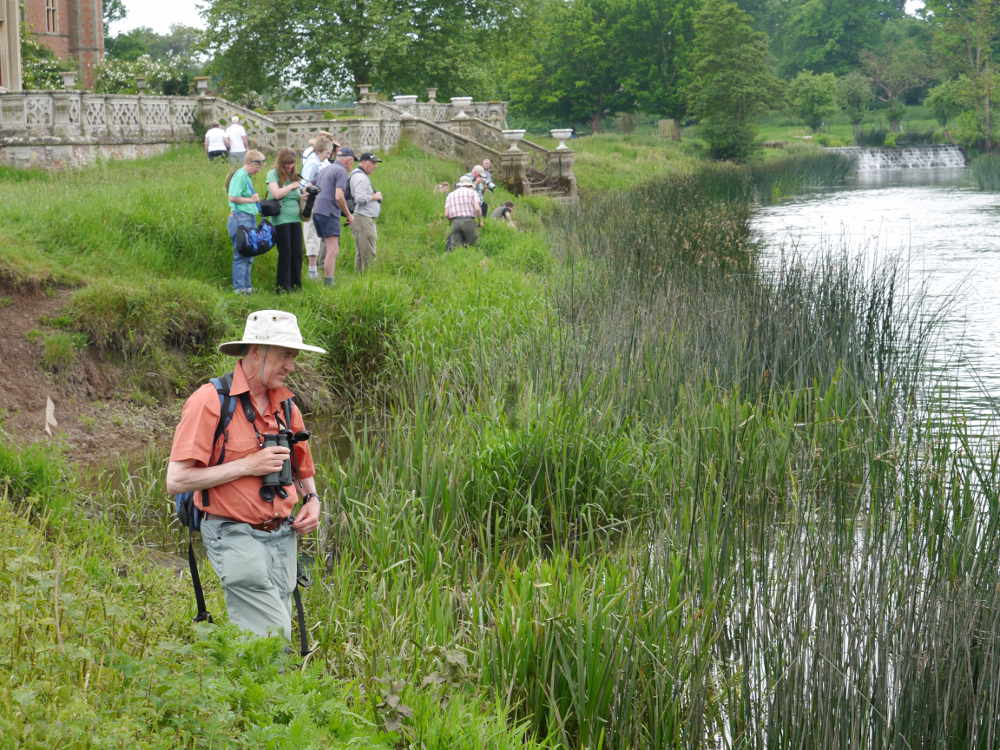
Photo by Kay Reeve
|
The purpose of this visit to the
National Trust property Charlecote House and Park was to attempt to find
emerging Scarce Chaser (Libellula fulva). They were first recorded here on the river Avon in small numbers in 2015.
There was a good turn out of
eighteen, mostly local WDG members but a few from further afield. Our
guide, Joy Margerum the Area Ranger for Chalecote Park, met us at the
car park. The
weather was chilly and windy with little sun after early morning rain -
this was after 4 or 5 days of a mini "heat wave". Even so, the day was
quite
suitable for finding emerging dragonflies and Joy led us off to the
rivers Dene and
Avon. We visited the rivers quite close to the house and specifically
that part of the river where Scarce Chaser was found in 2015. In
spite of a good number of pairs of eyes looking, photo left, we failed
to find any sign of the target species. However, there were good numbers
of Banded Demoioselle (Calopteryx splendens) including many newly emerged.
After a thorough search of the river bank we left to go to the pool. It
is very good habitat for odonata and did not disappoint. There were 10
to 20 newly emeged Black-tailed Skimmers (Orthetrum cancellatum)
many still with their exuvia. Some had travelled 10-20 metre from the
water though fairly rank grass before starting emergence. Also, there were
several Broad-bodied Chasers emerging. The few other species on the pool were: Blue-tailed Damselfly (Ischnura elegans), Large Red Damselfly (Pyrrosoma nymphula), Azure Damselfly (Coenagrion puella) and one or two Banded Demoiselles.
After lunch Joy took us to a part of the Avon in the deer park that is
closed to the general public. Again a search was made for Scarce Chaser
and again to no avail. However, there was a remarkable concentration of
Banded Demioselles sheltering from the now stronger wind and thickening
cloud in stands of nettles to the lee of a copse of trees. With that we
called the meeting to a close and repaired to the Charlecote House
tearoom.
Many thanks to the National Trust and particularly Joy for their cooporation.
|
Back to page top
May 22nd 2017 - Update on Flying species and Hairy Dragonfly at Ryton Wood
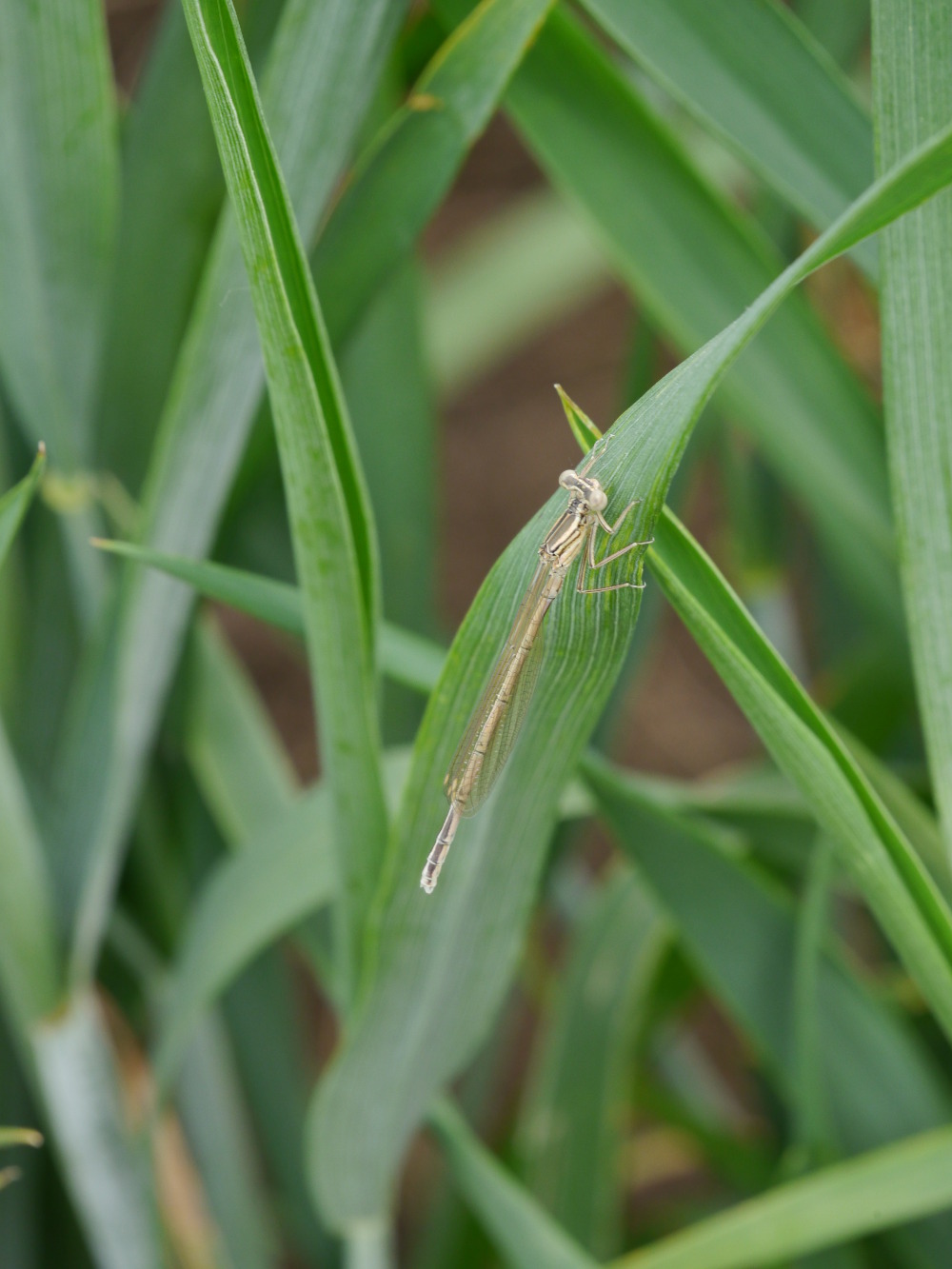
Photo by Kay Reeve - Immature White-legged Damselfly, Avon at Marlcliff
|
Since the posting on 7th May four additional species have been recorded flying. Mick Schilling recorded Beautiful Demoiselle
on the Arrow at Wixford on 15 May. He records here regularly and this is
the first time he has seen the species on this part of the Arrow. The
species was also recorded on the Stour near Brailes by by Jill Roberts.
Agni-Louiza Arampolglou has sent a record for Broad-bodied Chaser at Packmore Community Garden, The Cape Warwick the 14 May, about 3 weeks later than in 2011.
The other two species were seen by Kay and Peter Reeve on the Avon near Bidford on 22nd May. They were Red-eyed Damselfly and White-legged Damselfly
the first in 10s and 20s the second just 3or 4. A Red-eye exuvia was
recovered and the White-legged Damselfly was very immature,see the
picture.
|
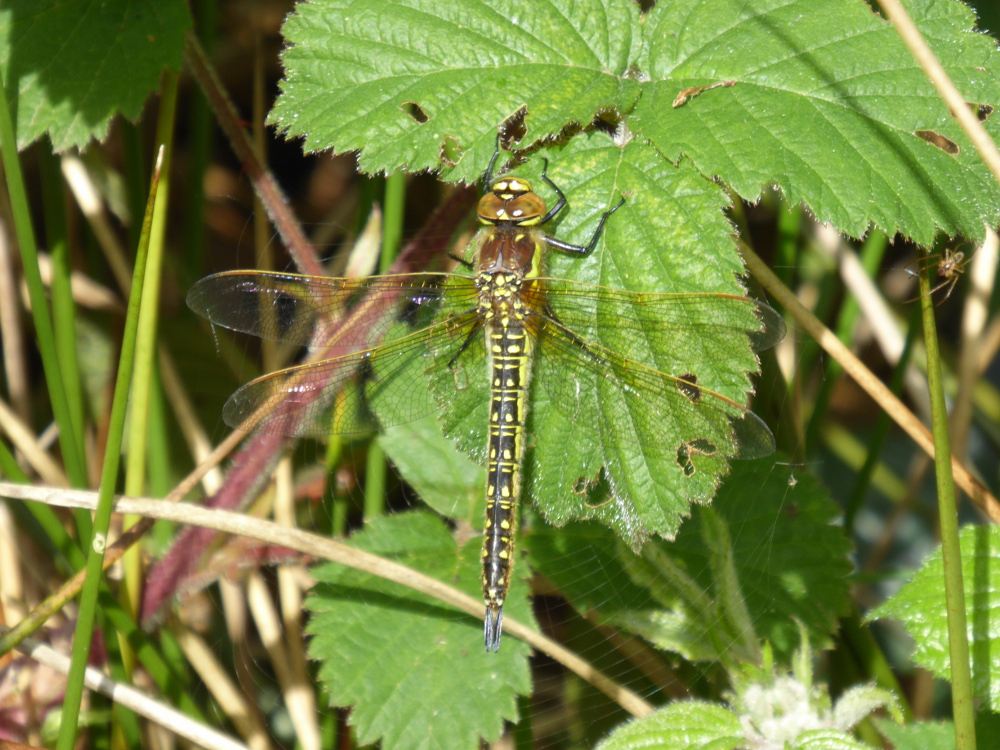
Photo by James Bennett -Female Hairy Dragonfly Ryton Wood
|
We now have another site where Hairy Dragonfly has been recorded, Ryton Wood. On 21st May James Bennett saw and photographed, left, a female. As James said in his male:
I first noticed a yellow dragonfly flying close to the vegetation near
the larger pond around 11am but
it disappeared over the pond after just a few seconds before I could
get a good look and I couldn’t relocate it. At this point I was
assuming it was a female broad-bodied chaser (but it seemed too big) or
black-tailed skimmer. I wandered off further into
the woods with the intention of heading to Bubbenhall meadow and
spotted the one I photographed about 5-10 minutes later heading East
from the ponds. It was probably 200-300m from the pond and I have a
feeling it was the same individual.
|
The first flights table is up to date.
Back to page top
May 7th 2017 - Azure Damselfly and Four-spotted Chaser flying - updated for Blue-tail and Hairy Dragonfly
After the early emergence of Banded Demoiselle and the Large Red and
Common Blue damselflies there has been a bit of a hiatus because of the
colder weather. Now with the weather warming again things are moving.
Bubbenhall Meadow seems to be doing well. Jim and Carol Timms sighted several Azure Damselflies at the Meadow on 3rd May and more Large Red Damselflies. A visit by Kay and Peter Reeve on the 7th May yielded good numbers of the three already recorded damselflies and the first record for the year for Four-spotted Chaser.
Kay and Peter watched a female emerging and Kay just missed the maiden
flight as she turned back to get the camera! Altogether there were four
or so individuals seen and four exuvia were collected.
After the first posting of this report more reports came in of two more species seen 7th May. Martin Roberts and Mick Schilling both reported a single Blue-tailed Damselfly at Chalecote Park Also the first Hairy Dragonfly of the year was seen at Alvecote Wood by Sarah Walters. She also reported about half a dozen Four-spots.
The first flights table has been updated.
Back to page top
April 22nd 2017 - A Common Blue Damselfly emerging and many Large Red Damselflies at Bubbenhall Meadow
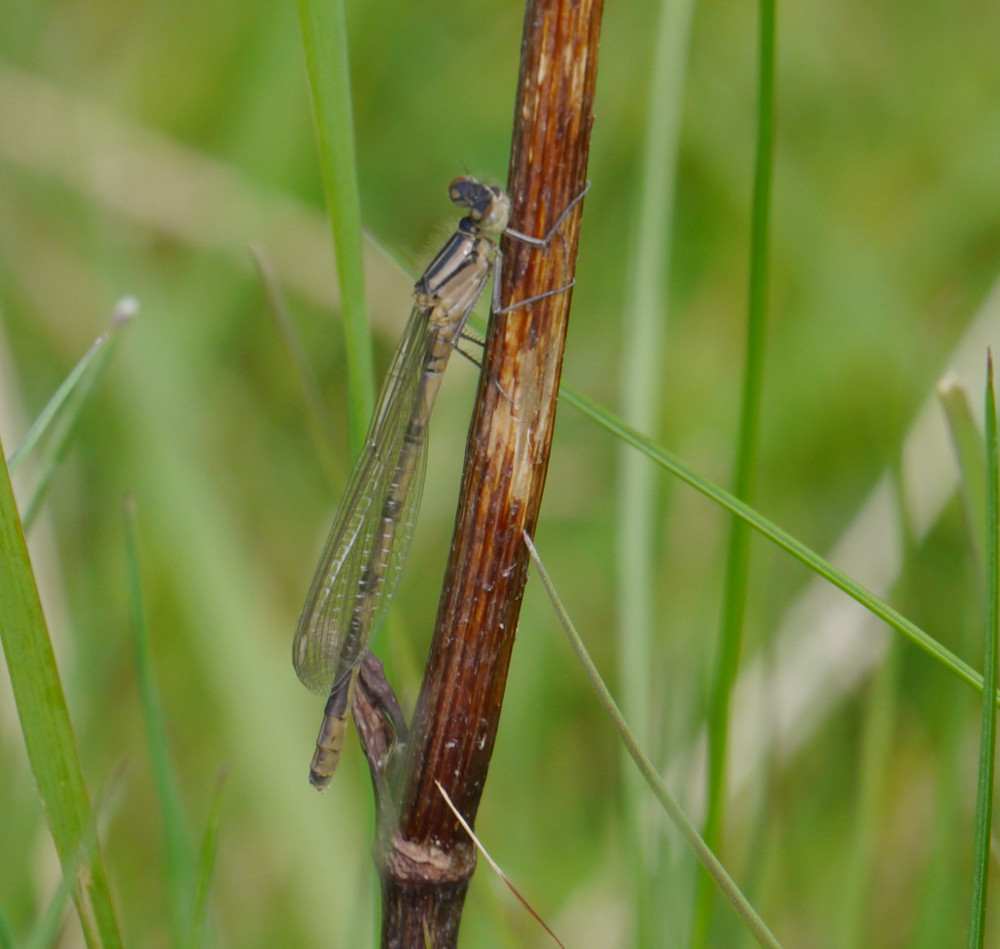
Photo by Kay Reeve - Common Blue Damselfly
|
Kay and Peter Reeve were going
round Bubbenhall Meadow with Steve Batt doing a preliminary survey of
the ponds and pools in preparation for Steve starting monitoring there
next month. It was a bright and sunny morning but there was nothing
showing on the large open pools. However, when we arrived at the first
pond we found many emerging Large Red Damselflies.
On the next three ponds there were as many or more emerging - we had
caught an "emergence day". No other species were seen at the ponds.
As we were returning to the car park Steve caught sight of a brown
damselfly. On closer examination it proved to be a newly emerged male Common Blue Damselfly,
see the photo left. The date of the sighting proved to be the earliest
ever record for Warwickshire by just one day! See the
first flights table. It almost certainly emerged from the adjoining large open pool - a habitat the species likes.
The three species recorded so far this year are all the earliest ever in
Warwickshire. This year could see more earliest ever sightings than the
record breaking year 2011. Get out and break a record!
|
Back to page top
April 13th
2017 - First flying damselflies this year and a very early Banded Demoiselle!.
|
April 4th - Remarkably early Banded Demoiselle emergence!
|
|
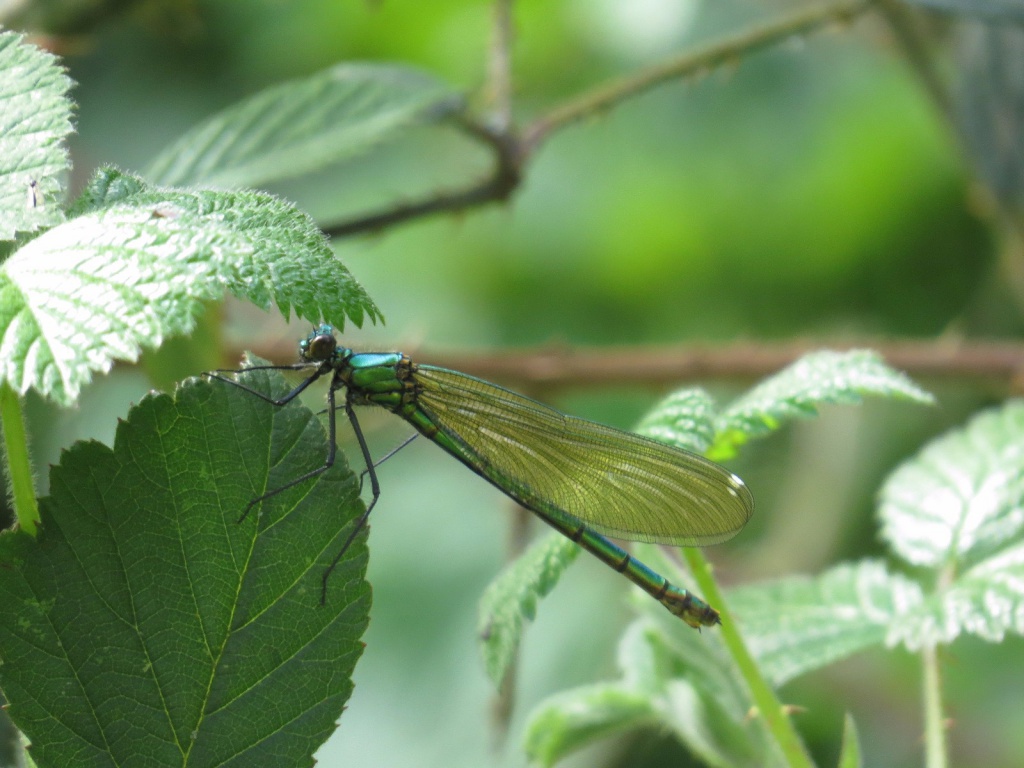
Photo by Paul Casey - Female Banded Demoiselle
|
I have just received notification of a sighting by Paul Casey of a female
Banded Demioselle
on the Tame at
Ladywalk Reservoir. This is a very early record,
by 16 days, for the species in Warwickshire and the UK - see the
first flights table. Indeed, it could prove to be the earliest ever UK record for an
emerged Banded Demioselle. Paul's photo shows a female that probably emerged at least a few
hours before it was taken, possibly even the previous day.
|
|
April 11th - First Large Red Damselfly of the year
|
|

Photo by Kay Reeve - Female Large Red Damselfly
|
Kay and I visited Bubbenhall Meadow NR on 11
April to discuss clearing paths for dragonfly monitoring
with the Nature Reserve maintenance team. As
we went round the ponds we disturbed four newly emerged
Large Red Damselfly.
One exuvia was recovered. This is
the first record of this early species this year
and is the earliest by one day that it has ever emerged in Warwickshire
-
unless someone has a earlier record for it this
year - see the first flights table.
|
Back to page top
March 31st
2017 - Using iRecord for your sightings.
All dragonfly records for Warwickshire can be entered online using the dedicated BDS iRecord entry form.
This can be found by following the link to
BRC Record Entry Form page.
iRecord sighting are sent to the county Dragonfly Recorder
for verification for Warwickshire - that is me, Peter Reeve.
iRecord is a very good way to get records to me. It avoids
transcription errors creeping in via the email or other routes.
But if you wish you can continue to send records to me by email
or post, that is perfectly acceptable.
Avoid using other iRecord forms such as General Data. If
possible, also avoid using other organisations dragonfly online recording
forms such as the RSPB, Butterfly Conservation, etc.
To get access to all the features available on the iRecord website it is necessary to create an account,visit the iRecord home page. Do not use the recording forms on the "Record" tab on this page, for preference go the
BRC Record Entry Form page where there are some useful suggestions for how some of the data should be entered or directly to the BDS recording page.
Back to page top
February
2017 - Report for 2016 published in the BDS Darter journal.
The BDS publishes the "Darter" every year. It is a communication
journal for the county recorders. Below is article supplied to the
journal for Warwickshire, VC 38. It is slightly different from the
published copy - some editing was done.
Warwickshire
– VC 38
Kay and Peter Reeve
For
the second year running there was a slow start to the flight season.
The first sightings of adults of many species were quite late. It was
not until mid-June that all our known breeding species were on the
wing. Some early species appeared quite late. For example,the first
flying Broad-bodied
Chaser Libellula
depressa
was seen on 17 May more than three weeks later than our earliest ever
date for the county of 12 April.
H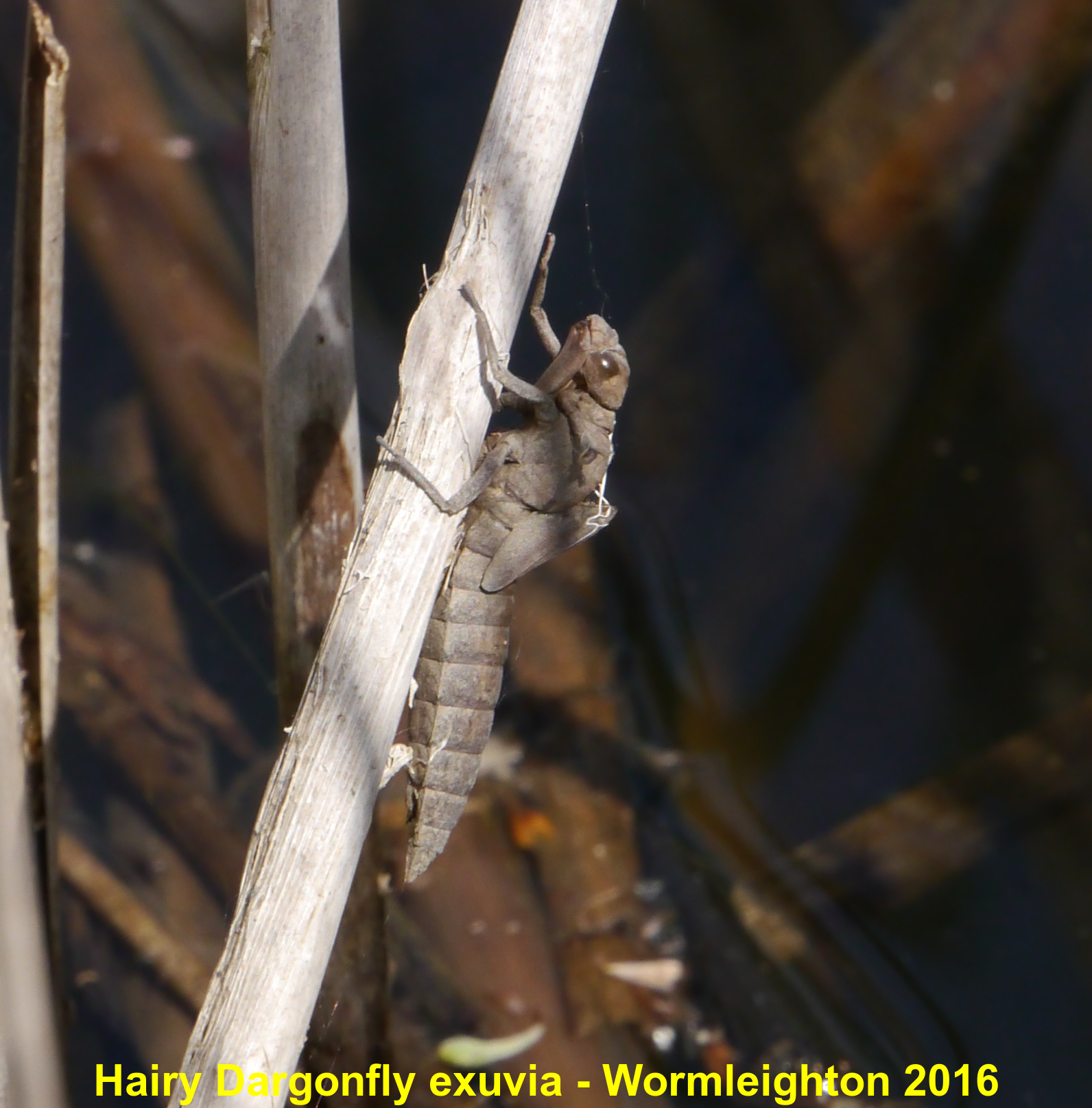 owever,
there were a number of new proof of breeding at sites in the county.
Exuvia of Hairy
Dragonfly
Brachytron
pratense
were found at Wormleighton Reservoir in the south-east and Alvecote
Wood in the north of the county. At both sites adults have been seen
for several years. This species is now present at thirteen sites that
are widely distributed in Warwickshire with breeding proved at four
(i.e. exuvia and/or emerging adults seen). owever,
there were a number of new proof of breeding at sites in the county.
Exuvia of Hairy
Dragonfly
Brachytron
pratense
were found at Wormleighton Reservoir in the south-east and Alvecote
Wood in the north of the county. At both sites adults have been seen
for several years. This species is now present at thirteen sites that
are widely distributed in Warwickshire with breeding proved at four
(i.e. exuvia and/or emerging adults seen).
For
several years Scarce
Chaser
Libullula fulva
has been found flying and showing breeding behaviour on the Avon at
Marlcliff. This year, for the first time anywhere in the county, an
exuvia and a preflight adult were found – the latter, sadly, had
been mortally wounded by some form of predation.
By
the end of June all our resident breeding species were seen on the
wing – including a sighting of the county rarity Scarce
Blue-tailed Damselfly
Ischnura pumilio
which is still holding on at its one vulnerable site.
We
had a rarely seen vagrant, Black
Darter
Sympetrum danae,
at Alvecote in the north of the county (a site with highly acidic
pools but devoid of sphagnum). It was last seen in the county in
2012.
Finally,
Jill Roberts photographed a Black-tailed
skimmer Orthetrum
cancellatum at
Winderton on 29th
September, a very late date for the species and the latest for it
flying in Warwickshire. Further, it still showed immature coloration
through blue pruinescence at several places on the abdomen - this
suggests it was fairly young. Not content with just a male and she
saw a female too and watched the two mating.
|
Back to page top
Banner artwork by Joan Sharrett Last updated Thu Nov 16 22:06:57 2017
| Visits since Oct 2010: 1416 |
|
 Bubbenhall Meadow continues giving. Yesterday, 15th November, Jim Timms saw a
Bubbenhall Meadow continues giving. Yesterday, 15th November, Jim Timms saw a  There are still late flying dragonflies, some in quite significant numbers. The
There are still late flying dragonflies, some in quite significant numbers. The  For damselflies the latest record received so far this year is for several
For damselflies the latest record received so far this year is for several  The histogram shows that the number of 2017 records received is high, the second highest year ever.
I know there are still a few more records to come in though whether they will be sufficient to exceed 2014 number is to be seen.
2017 is the first year that the iRecord
The histogram shows that the number of 2017 records received is high, the second highest year ever.
I know there are still a few more records to come in though whether they will be sufficient to exceed 2014 number is to be seen.
2017 is the first year that the iRecord 















 owever,
there were a number of new proof of breeding at sites in the county.
Exuvia of
owever,
there were a number of new proof of breeding at sites in the county.
Exuvia of